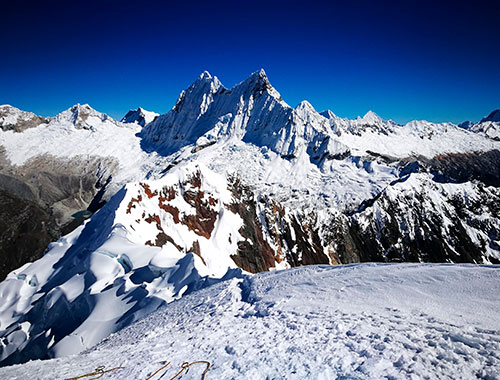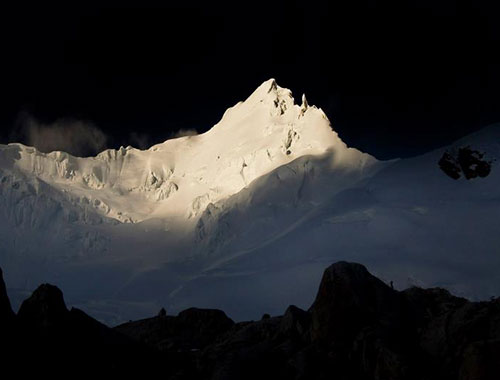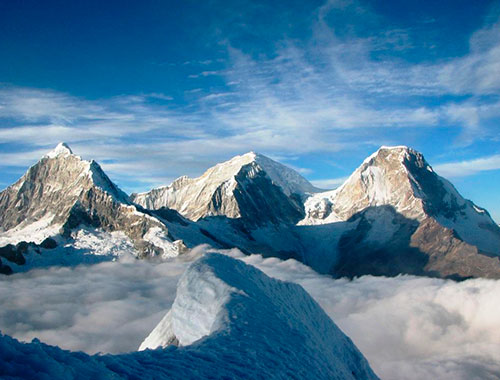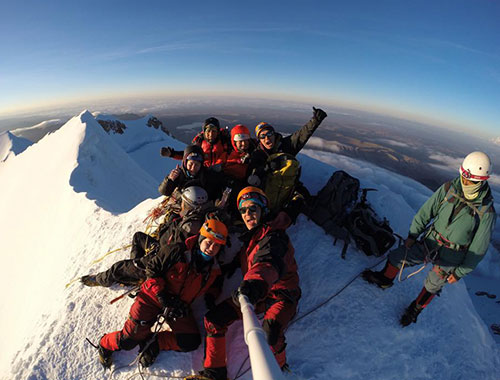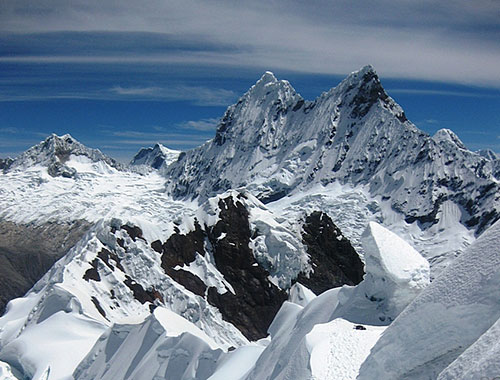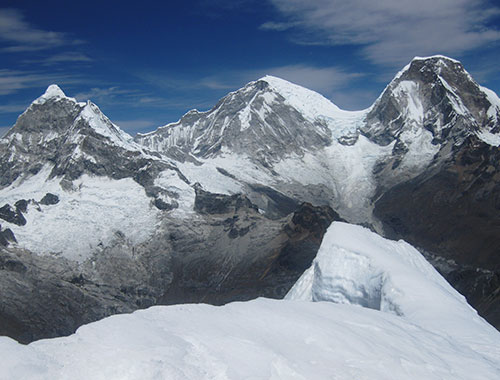Expeditions Nevados Alpamayo (5947 m), Artesonraju(6025 m) & Huascaran (6768 m)
Home / Mountaineering / Climbing Nevado Yanapaccha
- 24 Days/ 23 Nights
- April to November
- difficult
About Trekking Santa Cruz: One of the most popular treks in the Cordillera Blanca, the hike around this subtropical mountain range passes through impressive landscapes of uncommonly beautiful mountains, frequent lakes and glaciers. The camps are some of the most spectacular in the world. This is a short and very popular hike with spectacular views of lakes and mountains.
For acclimatization, we begin with a day hike to Laguna (Lake) Churup, at 4,450m. The highest and most demanding pass on the Santa Cruz trek is Punta Union Pass (4750m)
About Alpamayo Peak: The pyramid shaped Alpamayo is considered one of the most beautiful mountains in the world. The ascent toward the peak is very steep and the majority of it is a technical climb. This mountain should only be attempted by those who are well acclimatized and who have summited of other high peaks. From one side Alpamayo is an almost perfect pyramid, covered with enormous ice shelves. The other face, the trapezoidal southwest wall, is even more beautiful. All of the Cordillera Blanca mountain range is protected by Huascarán National Park, a paradise of snowcapped peaks. The park also includes the peaks of Huandoy and Huascarán (the highest mountain in Peru), as well as 663 glaciers, 269 lakes, some 42 rivers, as well as 33 archaeological sites.
About Artesonraju Peak: Artesonraju (6,025 m) is one of the approximately 50 peaks of the Cordillera Blanca known especially for its exceptional settings for mountaineering. Pyramidal and completely covered in ice and snow all year, this mountain of unequalled beauty is situated between the two gorges of the Santa Cruz Massif to the north and the Parón to the south. It’s frequently considered the iconic mountain in the Paramount pictures introduction.
From its high plateau alongside the Paron Gorge, it is 1,025 meters to the peak. It can usually be climbed in 8-12 hours round-trip. According to the International French Adjectival System (IFAS), it’s categorized as TD+: very difficult +, on the route of the South Ridge, and D: Difficult, via the “normal” route.
Artesonraju offers two primary ascent routes: The first runs through the North Edge, born in the Santa Cruz Gorge, while the second rises via the southeast face from Parón Lake, at the end of the gorge of the same name. This last route is very technically demanding, requiring advanced experience in ice climbing. You conquer a slope of 1,200 meters with a gradient that varies between 45 and 55 degrees, sometimes surpassing 60 degrees.
Avalanches are a common occurrence at the start of the climbing season, due to the large accumulation of snow on the steep slopes. During May and August, the strong winds produce the phenomenon known as “Placa de Viento“ or wind slabs – very dangerous because below a thin layer of ice there is spongy snow that doesn’t offer good anchor nor security.
About Huascarán Peak: Huascarán is the highest peak in Peru. This mountain has two summits: Huascarán North (6655 m) and the main summit, Huascarán South (6768 m). Many climbers dream of reaching this high summit of 6,768 meters. Technically, the climb is not difficult, nevertheless, due to its elevation and risk of avalanches, it is a serious climb.
The mountain offers multiple routes to arrive at the highest point in Peru. In any case, anyone attempting this peak should be well acclimatized to altitude before venturing to these huge glaciated mountains.
Observation: Huascarán South Summit (6.768 m) The conditions on all mountains change every year; particularly since the glacier between the first and second camps is receding. Accordingly, some years it is a challenge to get from High Camp 1 to High Camp 2 due to the crevasses and the large avalanches that can fall in the chute. An ascent of Huascarán is, without a doubt, one of the highlights of mountaineering in the Andes.
WHAT’S INCLUDED
Services included in the prices:
- Peruvian qualified and experienced local guide/s
- All meals during the tour
- Camping tents (2 persons)
- Porters Nevado Vallunaraju (2 pax 1 porter)
- Kitchen equipment
- Cooks
- Transportation as tour schedule / Huaraz
Not Included:
- International flights to Lima / Peru round trip
- Transfer from the airport for bookings of individual flights with different times of arrival / departure
- Exit tax at the airport in Lima
- Travel accident and health insurance
- Luggage insurance and trip cancellation
- Meals in restaurants in Lima and Huaraz
- Personal expenses
- Acclimatization Tour
- Entrance fees to the Huascaran National Park
- Transfer from the Hotel to the airport and bus station
- Domestic flight Airline ticket LC-Peru
- Hotel Casa Andina 2 nights in Lima
- Hotel San Sebastián 4 nights in Huaraz
- Pick up at the airport in Lima to the Hote
- Personal equipment (such as boots, ice ax, crampons, harness, sleeping bag, mat, Goretex, etc.)
- Tips
TOUR INFORMATION:
Season: April to November
Difficulty: Moderate
Dates & Prices:
More information about dates and prices upon request.

